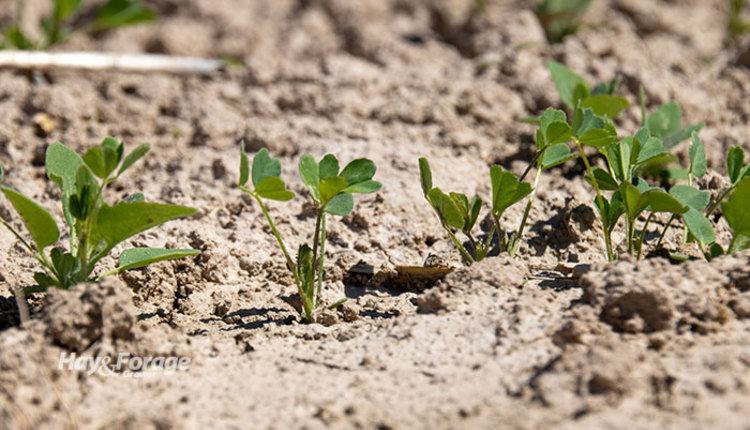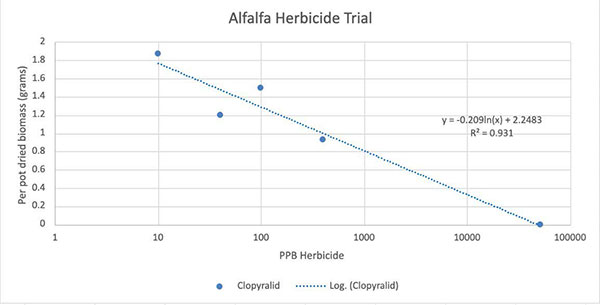
“Alfalfa is a solution to a lot of problems.” That’s how Mark Renz began his presentation at the Midwest Forage Association’s Symposium held last week in Wisconsin Dells, Wis.
The University of Wisconsin-Madison Extension weed management specialist noted that alfalfa is a cure for soil erosion, nutrient runoff and leaching, herbicide-resistant weeds, and insect pests such as corn rootworms.
Alfalfa plant establishment is the key to having a productive, long-term stand. “We’ve had challenges, in some cases, getting alfalfa established,” Renz said. “These stand failures have been caused by agronomic issues, weather issues, machinery issues, and soil-borne disease issues. But another problem we’re seeing more and more is failed stands being caused by herbicide carryover. One national agronomist has said that half of the stands he assessed for stand failure were the result of herbicide carryover,” he added.
Many herbicides being used on row crops such as corn have residual activity; they persist in the soil for longer-term weed control benefits. However, this can be a problem when they persist and cause damage to the next year’s crop.
“There is guidance on herbicide product labels that will tell you how long to wait before planting specific crops,” Renz said. “Sometimes the wording can be confusing, and often there are footnotes that add important information. These footnotes may change the basic recommendation because of factors such as rainfall, application date, soil organic matter, and/or soil pH.”
More postemergence applications
Why are we seeing an increase in alfalfa establishment problems as they relate to herbicide carryover?
Renz thinks it’s because more residual herbicides are being used in crops such as corn, and these herbicides are often being applied postemergence, which puts the timing really close to or over the rotational restriction for alfalfa.
In Wisconsin, there are about 22 residual herbicides that are used on corn. Renz said that about half of them have plant-back restrictions of less than 10 months. Forty percent of them are between 10 to 12 months. “Depending on when you’re spraying and when you’re planting the next year, you could easily be outside of that window,” Renz noted. “Another 10% of these herbicides are way above 12 months.”
Weather matters
Another factor playing into the upward trendline in herbicide carryover issues is extreme weather. The weed scientist said that extended dry conditions allow the herbicide to persist longer in the soil. Also, persistent rainfall at the wrong time delays the application of postemergence herbicides, which extends the plant-back time period farther into the next year.
“For some herbicides, their persistence becomes longer if they are applied repeatedly over time,” Renz said. “This is active ingredient specific.”
The herbicide active ingredient that Renz has the most concern about is clopyralid. In lab experiments, he’s demonstrated a sharp decline in aboveground biomass with relatively small concentrations of clopyralid in the soil (see figure below). Just 100 parts per billion had a profound impact on alfalfa growth.
Figure 1: Greenhouse study demonstrating the impact of clopyralid on alfalfa aboveground biomass 21 days after planting.

“We still have a lot of questions about herbicide carryover injury as it relates to alfalfa performance,” Renz asserted. “We don’t know how this type of injury interacts with other plant stresses. We also don’t know if herbicide injury is additive when multiple modes of action are applied in mixtures to the preceding crop. These are some of the questions we’re trying to answer.”
Read the label
Renz emphasized that the best way to minimize the impact of herbicide carryover injury is to follow the label instructions and make sure to read the footnotes. Pay attention to the weather conditions that occur between the herbicide application and the time you want to seed alfalfa. Drought will often extend herbicide activity in the soil. Rather than take a chance, forego an alfalfa seeding in the field and plant a tolerant crop.
“It’s always a good idea to rotate the herbicides being used to alleviate any long-term buildup in the soil,” Renz said. “If there is a carryover concern, and you still want to seed alfalfa, then disturb the soil with tillage. This will dilute the herbicide within the soil, and it will benefit additional microbial activity to break down the herbicide.”
In concluding, Renz told his audience to also consider the type of soil. A low-organic matter soil is more prone to have carryover issues because less of the chemical is bound to organic matter and more is available for plant uptake.

